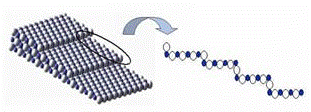Chemistry, Department of: Faculty Series

Marjorie A. Langell Publications
Document Type
Article
Date of this Version
May 1996
Abstract
Under mildly oxidizing ultrahigh vacuum conditions, it is possible to form on top of CoO(100) single crystal substrates, thin films that have higher oxygen content but that preserve the overall symmetry of the CoO(100) low-energy electron diffraction pattern. X-ray photoelectron spectroscopy (XPS) and high-resolution electron-energy-loss spectroscopy (HREELS) data indicate that the epitaxial film grown on CoO(100) at 625 K and 531027 Torr is Co3O3-like in both oxygen content and XP/HREEL spectroscopic characteristics. Both materials are closest packed in lattice oxygen, with the mismatch of bulk O2-–O2- distances of approximately 5%. However, the Co3O3 is only able to grow to a thickness of approximately 5 Å before the oxidation process halts. It is proposed that the orientation of Co3O3 that forms most readily on the CoO(100) surface does not present a thermodynamically stable orientation of the bulk Co3O3 substrate but is that which grows under the constraint of the best CoO(100)/Co3O3 epitaxial arrangement. While the mismatch in lattice parameters may in part be to blame for the limitation of higher oxide thickness, thicker oxide films have been grown under conditions with significantly larger mismatch.


Comments
Published by American Vacuum Society. J. Vac. Sci. Technol. A 14(3), May/Jun 1996. ©1996 American Vacuum Society. Permission to use.